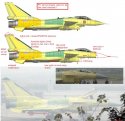You are using an out of date browser. It may not display this or other websites correctly.
You should upgrade or use an alternative browser.
You should upgrade or use an alternative browser.
J-10 Thread III (Closed to posting)
- Thread starter crobato
- Start date
- Status
- Not open for further replies.
More.
Hey ... I've never seen a twin-sticker with a probe !!! :china:
Deino
:china:I hope I didn't miss any changes ...
What do You think ???
Deino
AssassinsMace
Lieutenant General
Posted by gordanblade at CDF.




I have this picture saved from NRIET's website long ago. In fact, my picture file says May 27, 2003. Of course you won't find this in their website now.
So long ago, but it makes a lot more sense now.
Of course, just because the nose's diameter is oval doesn't suggest its an ESA, since there are oval radomes out there with slotted arrays like the APG-66 and APG-67. But the fact that the bulkhead wall that marks where the body ends and the radome begins is canted suggests the radar is fixed into a canted position. And the few radars that we know are fixed and canted are---
So long ago, but it makes a lot more sense now.
Of course, just because the nose's diameter is oval doesn't suggest its an ESA, since there are oval radomes out there with slotted arrays like the APG-66 and APG-67. But the fact that the bulkhead wall that marks where the body ends and the radome begins is canted suggests the radar is fixed into a canted position. And the few radars that we know are fixed and canted are---
Attachments
Last edited:
Ah ok. So would you say that picture is of a PESA or AESA? Or is that there much of a difference between the two in terms of use and looks?I have this picture saved from NRIET's website long ago. In fact, my picture file says May 27, 2003. Of course you won't find this in their website now.
So long ago, but it makes a lot more sense now.
Of course, just because the nose's diameter is oval doesn't suggest its an ESA, since there are oval radomes out there with slotted arrays like the APG-66 and APG-67. But the fact that the bulkhead wall that marks where the body ends and the radome begins is canted suggests the radar is fixed into a canted position. And the few radars that we know are fixed and canted are---
Everyone says AESA's better of course, but why is PESA inferior?
Last edited:
PESA only has one emitter to feed the entire array even though the array consists of elements each with its own phase shifter, whereas AESA has one emitter inside every element. AESA wins by sheer redundancy. AESA has the advantage of being able to send in multiple frequencies by grouping sets of elements to to one frequency, but I won't call this advantage to be that important since you can always time share different frequencies with a single emitter.
AESA actually works better for China's technology and industrial infrastructure. Powerful PESAs need powerful emitters to match, something the Russians have developed very well. For all its worth, its actually easier to develop an AESA because its better to just use lots of small emitters instead of one godzilla emitter. China skipping into AESA may have something to do with this. It works with the current industrial infrastructure, since AESA elements currently use GaAs, a semiconductor used mostly with LCD displays, and guess who makes a lot of LCD displays.
The arrays on the KJ-200 (not the KJ-2000), and the 052C are more likely to be AESAs too. Another AESA application is the SLC-2 artillery spotting radar.
AESA actually works better for China's technology and industrial infrastructure. Powerful PESAs need powerful emitters to match, something the Russians have developed very well. For all its worth, its actually easier to develop an AESA because its better to just use lots of small emitters instead of one godzilla emitter. China skipping into AESA may have something to do with this. It works with the current industrial infrastructure, since AESA elements currently use GaAs, a semiconductor used mostly with LCD displays, and guess who makes a lot of LCD displays.
The arrays on the KJ-200 (not the KJ-2000), and the 052C are more likely to be AESAs too. Another AESA application is the SLC-2 artillery spotting radar.
- Status
- Not open for further replies.


